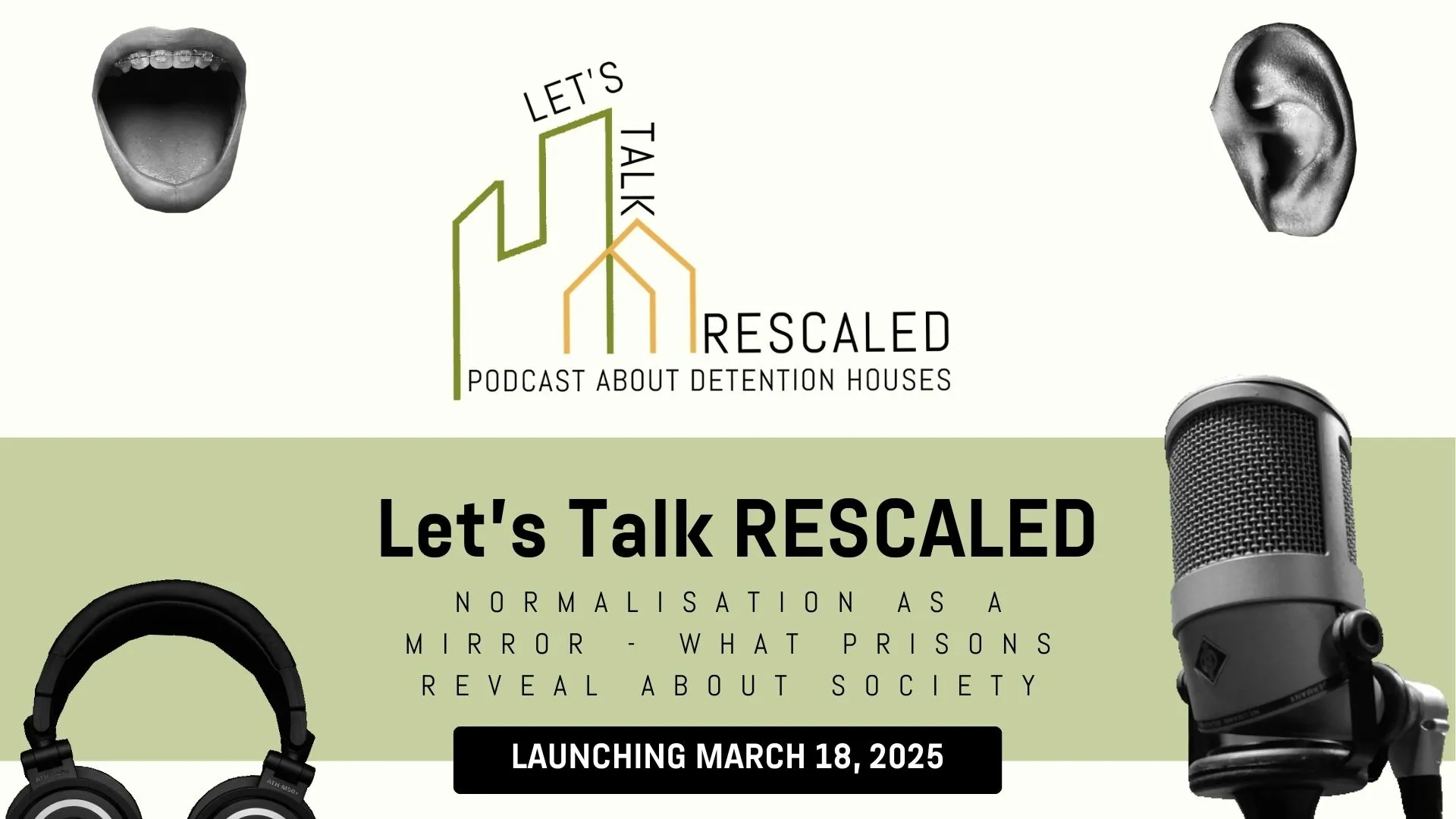Graduated with a Master’s degree in International Humanitarian Law and International Human Rights Law (IHRL), my first encounter with prisons’ issues were mostly through a legal prism. My first experience with the detention environment took place during an internship in a human rights organisation in Lomé (Togo). Here, I carried out monitoring activities in detention with the aim of submitting an alternative report to the United Nations human rights bodies on the issues of the carceral system in the country. Afterwards, I continued to study the provisions of the IHRL regarding detention through my academic and professional experiences.
Currently I am working as assistant coordinator of RESCALED in France. In this respect, taking my background knowledge into account, it is interesting to question in what way RESCALED is relevant from an IHRL point of view.
1. Prisons and human rights: Key principles of the IHRL
First, I will recall the main principles of the IHRL regarding detention.
Some International and Regional Human Rights norms are specifically focused on the treatment of incarcerated persons and others include references to this. Although deprivation of liberty is allowed under the IHRL, it must be carried out in a humane and dignity-respecting manner.[1] Persons deprived of their liberty continue to have their fundamental rights, without other restrictions than those inherent to detention.[2] Consequently, incarcerated persons may not be subjected to inhumane and degrading treatment. The European Court of Human Rights, like other human rights bodies, has qualified the conditions of detention as inhumane and degrading in several cases.[3] This qualification is based on the size of the individual space, access to walks and activities, privacy, access to natural light, ventilation and hygiene, amongst other things.[4] In addition, other rights that are guaranteed by international texts, such as the right to privacy and family,[5] freedom of religion,[6] the right to vote,[7] the right to health,[8] etc. also apply to incarcerated persons.
2. RESCALED in the light of the IHRL: Pillars in compliance with human rights
The majority of prison systems face problems, such as overcrowding, characteristics of facilities and difficulties in accessing care and activities, that prevent prisons from meeting these IHRL standards.
By proposing a new model for places of deprivation of liberty, RESCALED offers an alternative that can be compliant with the requirements of the IHRL: replacing the current large prison institutions by small-scale, community-integrated and differentiated detention houses.
2.1 Small-scale – Normalization
First of all, with the principle of a small-scale house instead of a large prison institution, RESCALED aims to normalize the conditions of detention, i.e. to create a place of deprivation of liberty in which the conditions of life resemble as closely as possible those of life in freedom.[9] Normalizing detention conditions is in accordance with international principles on detention. The European Prison Rules state that “life in prison shall approximate as closely as possible the positive aspects of life in the community“,[10] and the United Nations Standard Minimum Rules for the Treatment of Prisoners (hereafter referred to as the Nelson Mandela Rules) state that “the prison regime should seek to minimize any differences between prison life and life at liberty“.[11]
2.2 Community integration
Second, the detention house should be community-integrated, which creates a dynamic interaction between the detention house and the community and thus facilitates the reintegration into society. This is in line with international texts which indicate that the treatment of persons should aim primarily at the reintegration,[12] reformation and social rehabilitation of incarcerated persons.[13] In particular by “establish[ing] in them the will to lead law-abiding and self-supporting lives after their release and to fit them to do so [and] encourag[ing] their self-respect and develop their sense of responsibility”.[14]
The community integration of detention houses, that RESCALED proposes, echoes international provisions. These state that prisons should encourage incarcerated persons to establish or strengthen relationships with external persons and organisations that can assist their reintegration and that “co-operation with outside social services and as far as possible the involvement of civil society in prison life shall be encouraged”. More specifically, prison systems are encouraged to strengthen or establish links with public health services to enable continuity of care and access to the same standard of care. By giving incarcerated persons a role in the community and having them interact with the community, RESCALED adheres to these principles of international law and even seeks to go further.
2.3 Differentiation
By differentiation of detention houses RESCALED aims to place incarcerated persons in the best context according to their needs. Namely providing the right security level and offering services, activities and programs that fit the needs of the residents.
The Nelson Mandela Rules provide that incarcerated persons should be placed in groups to ensure that they are treated according to their abilities and needs with a view to their social reintegration.[15] Detention houses, given their small scale and the differentiation of the programmes they offer, therefore make it possible to meet these requirements in a comprehensive manner.
Differentiation, according to the security level and the introduction of dynamic security, also meets the requirements of the Nelson Mandela Rules, which state that detention facilities should not provide the same level of security for all incarcerated persons and should have varying degrees of security according to the needs of different groups.[16] By offering a level of security that is appropriate to the risks posed by individuals, detention houses seek to balance security, humane treatment and preparation for release and therefore propose to implement the principles set out in the above rules.
3. The IHRL to change the detention framework?
In conclusion, RESCALED, through the three pillars of a detention house, suggests a model that seems to meet the requirements of the IHRL and seems to be likely providing solutions to the violations of fundamental rights witnessed in detention today.
Furthermore, the inscription of RESCALED in these legal principles could lead to thinking of the IHRL as a means to change the framework of penitentiary systems. While international law can be seen as relatively indeterminate and allowing interpretations of norms and concepts,[17] it is still marked by balances of power in favour of the interests of some actors over others.[18] It is therefore possible to question whether IHRL has the potential to be a means of changing the framework of penitentiary systems or whether it is rather a tool to identify and respond to problems without changing this framework.
In this respect, it seems interesting to broaden the reflections on detention, on its being, functions, place in society, etc. Because of the interdisciplinary approach of RESCALED, we question those aspects and shine a new light on detention.
[1] See for example: Article 10 International Covenant on Civil and Political Rights (ICCPR).
[2] See for example: Human Rights Council, resolution 24/12, 26 September 2013. European Court of Human Rights (ECHR), Campbell and Fell v. UK, n°7819/77 and 7878/77, 1984.
[3] See for example: ECHR, J.M.B. and others v. France, n°9671/15 and others, 2020. Human Rights Committee, Brown v. Jamaica, 775/1997, § 6.13.
[4] See for example: ECHR, Muršić v. Croatia, n°7334/13, 2016. ECHR, Cucolas v. Roumania, n°17044/03, 2011.
[5] Article 8, European Convention on Human Rights. Article 17, ICCPR.
[6] Article 9, ECHR. Article 18, ICCPR.
[7] Article 3, 1st Additional Protocol to the ECHR. Article 25, ICCPR.
[8] Article 12, International Covenant on Economic, Social and Cultural Rights.
[9] Dan Kaminski, “Droits des détenus, normalisation et moindre éligibilité”, Criminologie, vol 43, n°1, spring-summer 2010.
[10] Rule 5, European Prison Rules.
[11] Rule 5.1, United Nations Standard Minimum Rules for the Treatment of Prisoners
[12] Rule 4.1, United Nations Standard Minimum Rules for the Treatment of Prisoners
[13] Article 10.3, ICCPR
[14] Rule 91, United Nations Standard Minimum Rules for the Treatment of Prisoners
[15] Rule 93 and 94, United Nations Standard Minimum Rules for the Treatment of Prisoners
[16] Rule 89.2, United Nations Standard Minimum Rules for the Treatment of Prisoners
[17] Martti Koskenniemi, “From Apology to Utopia – The structure of international legal argument”, Epilogue, 2005
[18] Rémi Bachand, “Les quatres strates du droit international analysées du point de vue des subalternes”, Revue Québécoise du droit international, 2011.















